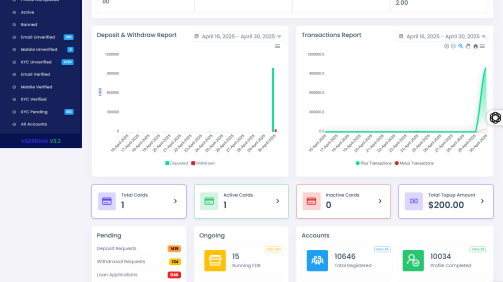🧩 System Features
1. Capture & Ingestion
- Multi-Channel Capture: Supports capturing correspondence via scanners, email, manual uploads, fax, mobile devices, and integration with external systems.
- Scanning & Upload: High-quality scanning with support for various document formats.
- Mobile Imaging Framework: Includes features such as:
- Image compression
- Orientation detection
- Noise removal
- Geo-tagging for location tracking
2. Document Management
- Centralized Repository: A unified platform to store all incoming and outgoing correspondence securely.
- Version Control: Maintains historical versions of documents.
- Indexing & Metadata: Classifies documents with metadata for efficient retrieval.
- Role-Based Access: Access control down to the object level to ensure confidentiality.
- Secure Folders: Access-controlled folders for internal and external users.
3. Records Management
- Retention Policies: Automated retention and rollover based on rules.
- Transfer & Archival: Seamless document transfer to archives after lifecycle completion.
- Certified Compliance: Adheres to international certified records management standards.
- Audit Trails: Complete traceability of document lifecycle events.
4. Process Management
- Task Assignment: Automatic or manual assignment of correspondence tasks to individuals or departments.
- Workflow Management: Includes both flexible and sequential routing mechanisms.
- Rule Engine: Automates routing and escalation based on predefined conditions.
- Delegation of Authority: Allows forwarding and assignment of tasks to appropriate users.
- Exception Resolution: Manages re-routing, follow-ups, and conflict handling.
5. Inward & Outward Correspondence Handling
- Inward Correspondence:
- Scan or upload incoming documents
- Register, classify, assign, and track
- Automatically delegate to respective departments or officials
- Maintain and track correspondence in registers
- Outward Correspondence:
- Create, review, approve, sign, and send documents
- Maintain audit trails of reviews and approvals
6. Search & Retrieval
- Smart Search: Supports full-text search, keyword search, and classified search.
- Indexing Engine: Ensures fast, accurate retrieval using metadata.
- Tracking: Enables real-time search and tracking using dashboards and audit tools.
- RFID/Barcode: Integrated support for barcode and RFID tagging to manage physical correspondence.
7. Notifications & Alerts
- Multi-Channel Alerts:
- Email notifications
- SMS alerts
- In-app alarms
- Deadline reminders
- Status Updates: Provides real-time status of documents and workflows.
8. Reporting & Monitoring
- Dashboards: Visual representations of performance indicators, statuses, and workload.
- Reports: Generate reports for audit, SLA tracking, pending tasks, and completion rates.
- Activity Monitoring: Real-time insights into document status and process activities.
- Analytics: Helps decision-makers track trends and optimize performance.
9. Security & User Management
- Secure Access Control:
- Role-based access down to object/document level
- Centralized user management system
- Integration with enterprise directory services (LDAP, AD)
- Password & Access Policies:
- Enforces password policies and access expiration rules
- Supports digital certificates for secure transactions
- Confidentiality Controls:
- Flag sensitive content
- Limit viewing or editing to authorized personnel only
10. Enterprise Integration
- Compatible and integrable with:
- ERP applications
- Email servers (e.g., Microsoft Exchange, Gmail for Business)
- Record management systems
- User authentication systems (SSO)
- Other enterprise applications through APIs
🔄 System Workflow Process
Step 1: Capture
- Correspondence is captured via scan, upload, or automatic import from integrated systems.
Step 2: Classification
- The document is classified by type, origin, priority, and assigned metadata.
Step 3: Assignment
- Automatically or manually assigned to the appropriate user, role, or department.
Step 4: Processing
- Routed through the defined workflow.
- Reviewed, approved, signed, or delegated as required.
Step 5: Tracking & Monitoring
- The correspondence status is updated in real-time.
- SLA tracking ensures deadlines are not missed.
Step 6: Archival
- Upon completion, the correspondence is archived in the secure central repository.
- Retention and transfer rules are applied automatically.
🎯 System Benefits
✅ Operational Efficiency
- Automates manual tasks such as scanning, routing, and approvals
- Reduces processing time and eliminates document misplacement
✅ Improved Accessibility
- Centralized repository allows instant access to any document, anytime
- Smart search features simplify information retrieval
✅ Enhanced Visibility & Control
- Dashboards and reports provide real-time insight into correspondence flow
- Helps identify bottlenecks and improves accountability
✅ Compliance & Governance
- Adheres to certified international records management standards
- Ensures audit readiness and regulatory compliance
✅ Security & Confidentiality
- Fine-grained access control keeps sensitive data protected
- Enforced authentication and authorization policies
✅ Cost Reduction
- Saves storage and printing costs
- Minimizes delays and resource wastage
✅ Scalability & Flexibility
- Supports organizational growth with configurable workflows and user roles
- Can be adapted to multiple departments or agencies
✅ Platform Independence
- Compatible with multiple operating systems and deployment models (cloud/on-prem)





